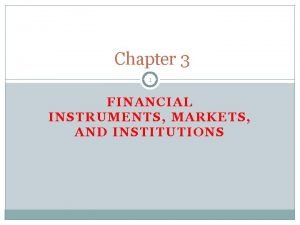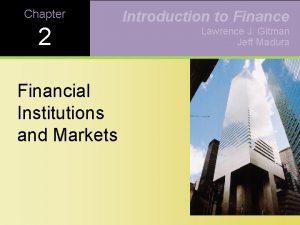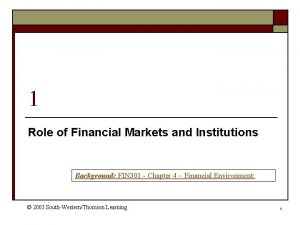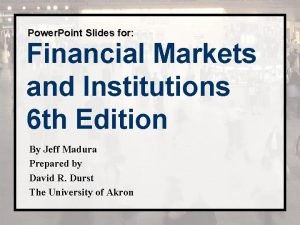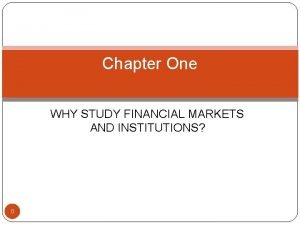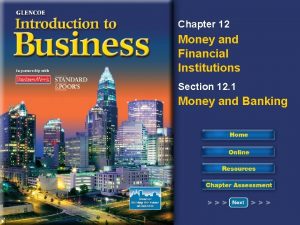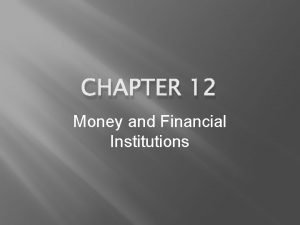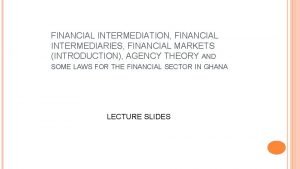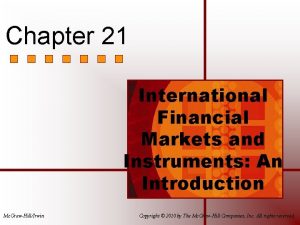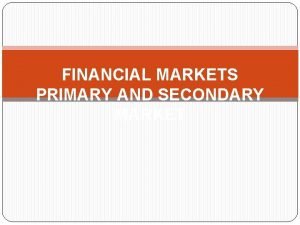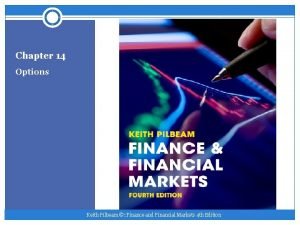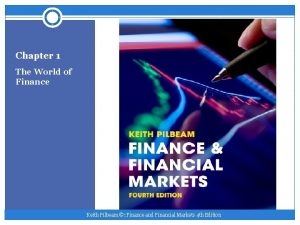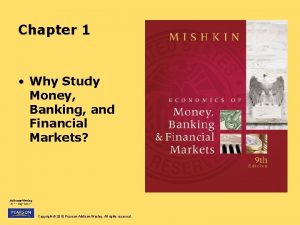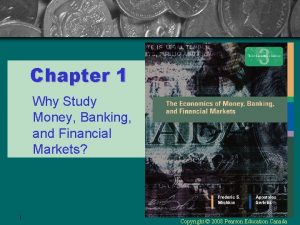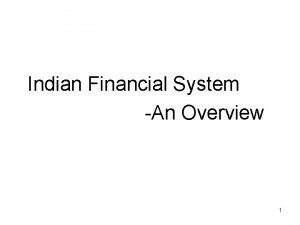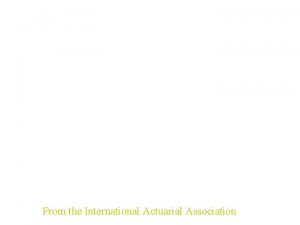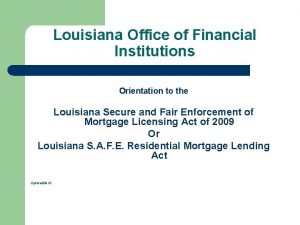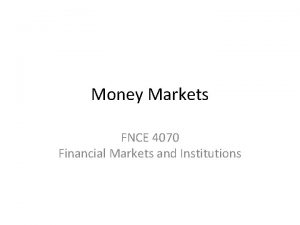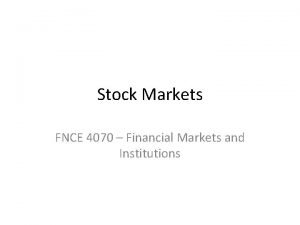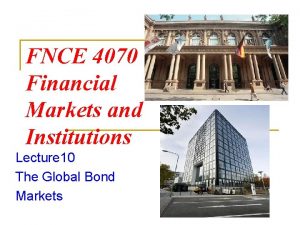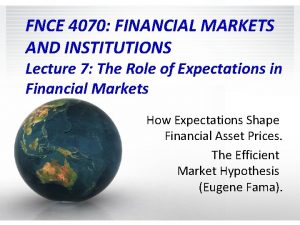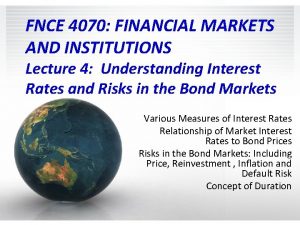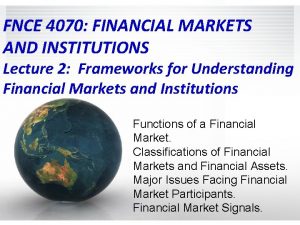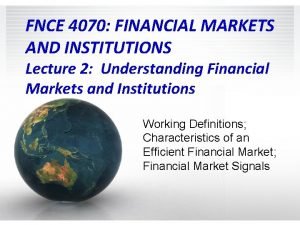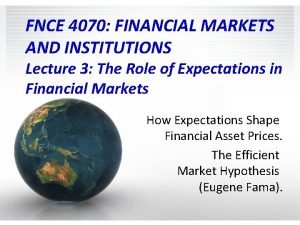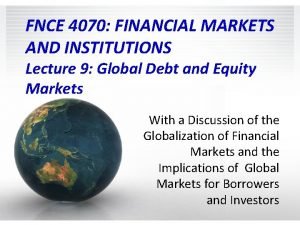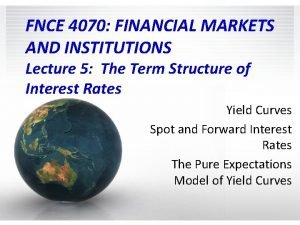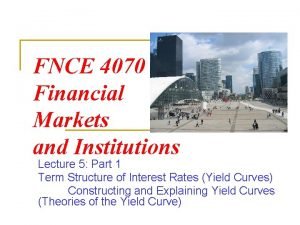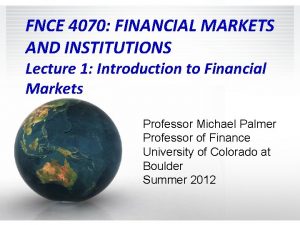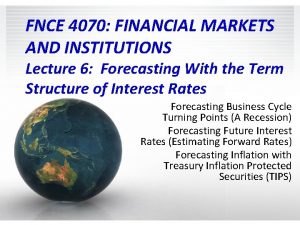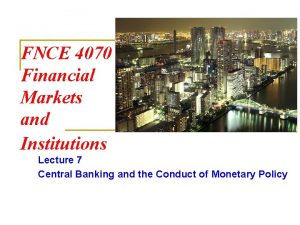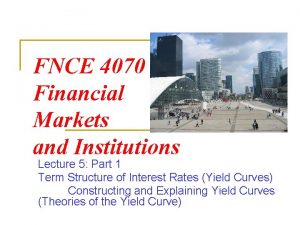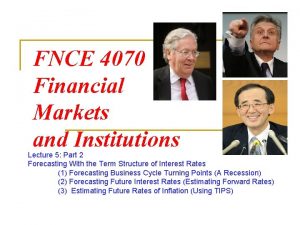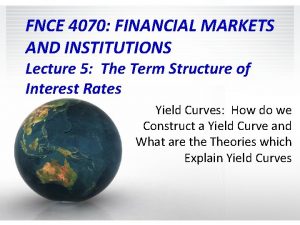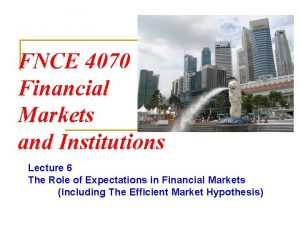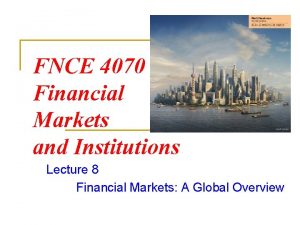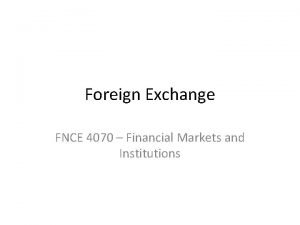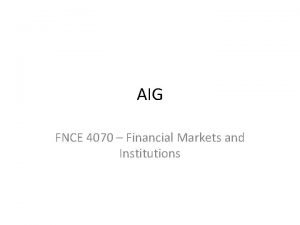FNCE 4070 FINANCIAL MARKETS AND INSTITUTIONS Lecture 8




























- Slides: 28

FNCE 4070: FINANCIAL MARKETS AND INSTITUTIONS Lecture 8: Financial Markets, A Global View With a Discussion of the Globalization of Financial Markets and the Implications of Global Markets for Borrowers and Investors

Where are these Financial Centers? Shanghai. Goal: “Major international financial center by 2020. ” Singapore: 321 foreign companies listed on the SGX (47% of total market capitalization). Dubai (UAE): The market serving the region between Western Europe and East Asia. Trading in equities, derivatives, foreign exchange and Islamic bonds. São Paulo (Brazil): Home of Latin America’s largest stock exchange, which includes a carbon trading program.

Theme of This Lecture q q Since the early 1970’s, the globalization of financial markets has been a dominant theme in international finance. This globalization has resulted in: n n n Expanded opportunities and expanded risks for participants in global financial markets. Spillover effects from one country (or region) to another. Reduction in the historical dominance of U. S. financial markets; this is illustrated in the following 2002 to 2010 data for the United States: q q n Share of world’s capital market from 34% to 26%. Share of the world’s stock market from 49% to 31%. Share of the world’s bond market from 44% to 34%. Share of the world’s banking market from 15% to 14%. Growing importance of emerging country financial markets q 11% of world’s capital markets in 2002 to 21 % in 2010

Financial Market Globalization n n Financial market globalization refers to the integration of national financial markets. This process can be represented by: q q n (1) various financial institutions including banks and institutional investors expanding their activities geographically, thus acting as intermediaries to channel funds from lenders to borrowers across national borders and (2) securities markets becoming more cross-border orientated. Bottom line: Financial market globalization has greatly expanded the range of borrowing, lending and investing possibilities available to economic agents (companies, governments, individuals) throughout the world.

Brief History of Financial Market Globalization n Some researchers argue that the integration of financial markets, when measured by cross-border capital flows across national borders, is not a new phenomenon. For example, in the 50 years prior to WWI (1914), the world saw massive capital flows from Western Europe to overseas regions of recent settlements (mainly the Americas). During this time, private capital moved cross border with essentially no restrictions, much of it going into bonds financing railroads and other infrastructure investment and long term government debt.

Financial Market Globalization: From the 1970’s to the Present n n n The second wave of financial market globalization can probably be traced to the demise of the Bretton Woods system in the early 1970 s. This move towards floating exchange rates (with less government intervention) ushered in an era of progressive dismantling of controls on cross-border financial flows as well as the liberalization of national financial markets more generally. In addition, technological advances played a key role. q q Information systems are now able to compute and store more data more rapidly. Telecommunications networks have made it possible to connect in more efficient ways. As a result, cross-border financial deals have become both easier and more secure, effectively lowering the barrier constituted by distance.

Examples of Major Deregulations of Financial Markets: U. K. and Japan n U. K. 1979: Margaret Thatcher removed all n n exchange controls on the pound. U. K. 1986: “Big Bang, “ London stock exchange: Removal of barriers to foreign brokers on the exchange. Japan 1984: Yen-Dollar Agreement: q q q Opened up access of Japan’s financial markets to foreign firms. Removal of controls regarding conversion of yen in FX markets. Permitted yen offshore transactions.

Implications of Financial Market Globalization n n The globalization of financial markets has resulted individual markets become more integrated and more open to non-resident borrowers and investors. As a result, opportunities for obtaining capital and investing capital have widened. q q n Today it is commonplace for a corporation to consider raising capital in foreign countries and denominating in any one of a number of currencies. Today it is also commonplace for an investor to consider investing in foreign countries and doing so in any one of a number of currencies. Globalization has also resulted in an expanded set of risks for participants

Global Financial Markets: 2010 n By year end 2010, global financial markets were estimated at $250. 0 trillion dollars. The break down was as follows: q q Stock Market Capitalization: Debt Securities: n n q q n $55. 1 trillion (47. 2) $94. 8 trillion (92. 1) Of which: Public (Government) Debt Of which: Private Debt Bank Assets: $41. 4 trillion $53. 5 trillion $100. 1 trillion (103. 8) Note: Year end 2009, global financial markets were estimated at $242. 3 trillion (data in parenthesis are 2009). In 2010, global financial markets were 4 times the size of world GDP. Source: IMF, Global Financial Stability Report, September 2011 q http: //www. imf. org/External/Pubs/FT/GFSR/2010/02/index. htm

World’s Capital Market, 200122010 (Trillions of USD) $ 300, 00 $ 242, 26 $ 241, 09 $ 250, 00 $ 250, 07 $ 221, 49 $ 194, 46 $ 200, 00 $ 152, 33 $ 150, 00 $ 100, 00 $ 165, 13 $ 130, 34 $ 106, 44 $ 50, 00 $2002 2003 2004 2005 2006 2007 2008 2009 2010

Individual Financial Markets, Percent of Total, 2002 - 2010 45, 0 40, 0 34, 0 35, 0 33, 4 33, 8 30, 0 25, 7 25, 0 20, 6 20, 0 15, 0 10, 0 14, 3 11, 8 11, 3 5, 0 0, 0 2002 2003 U. S. Japan 2004 2005 E. U. 2006 2007 2008 2009 Emerging and Newly Industrialized Markets 2010

Components of the World’s Capital Market, 2002 - 2010 Trillions of USD 120, 00 Percent of Total 50, 0 45, 0 100, 00 40, 0 37, 9 35, 0 80, 00 30, 0 60, 00 25, 0 22, 0 20, 0 40, 00 15, 0 10, 0 20, 00 5, 0 0, 00 2002 2003 2004 2005 2006 2007 2008 2009 2010 Stock Market Debt Market Bank Market 0, 0 2002 2003 2004 2005 2006 2007 2008 2009 2010 Stock Market Debt Market Bank Market

U. S. Capital Market, 2002 - 2010 Trillions of Dollars Share of World Capital Market (Percent) 70, 00 40, 0 60, 00 35, 0 30, 0 50, 00 33, 8 25, 7 25, 0 40, 00 20, 0 30, 00 15, 0 20, 00 10, 00 5, 0 0, 0 2002 2003 2004 2005 2006 2007 2008 2009 2010 U. S.

Components of U. S. Capital Market, 2002 - 2010 Percent of Total U. S. Market Trillions of Dollars 35, 00 60, 0 52, 9 30, 00 50, 7 50, 0 25, 00 40, 0 20, 00 30, 7 30, 0 26, 9 15, 00 20, 0 10, 00 16, 4 10, 0 5, 00 0, 00 22, 3 2002 2003 2004 2005 2006 2007 2008 2009 2010 Stock Market Debt Market Bank Market 0, 0 2002 2003 2004 2005 2006 2007 2008 2009 2010 Stock Market Debt Market Bank Market

55, 0 50, 0 U. S. Capital Market Components as a Percent of World’s Capital Market Components 48, 5 45, 0 40, 0 43, 7 35, 0 34, 3 31, 4 30, 0 25, 0 20, 0 15, 0 14, 7 14, 3 10, 0 2002 2003 2004 2005 2006 Stock Market Debt Market 2007 2008 Bank Market 2009 2010

Emerging and Newly Industrialized Capital Markets Trillions of USD Percent of World’s Capital Markets 70, 00 30, 0 60, 00 25, 0 50, 00 24, 2 20, 0 40, 00 15, 9 15, 0 30, 00 10, 0 20, 00 11, 3 11, 6 12, 0 16, 4 13, 4 5, 0 10, 00 20, 6 19, 5 2002 2003 2004 2005 2006 2007 2008 2009 2010 Emerging and Newly Industrialized Markets 0, 0 2002 2003 2004 2005 2006 2007 2008 2009 2010 Emerging and Newly Industrialized Markets

Equity Markets, 2010, Trillions of USD (% of Total) n World: q q q U. S. : Japan: EU: n n q q $55. 1 UK: France: Germany: Euro Area: $17. 3 (31. 4%) $ 4. 1 ( 7. 4%) $10. 7 (19. 4%) $ 3. 6 $ 1. 8 $ 1. 4 $ 6. 2 Newly Industrialized Asia* Emerging Countries: ( 6. 5%) ( 3. 3%) ( 2. 5%) (11. 3%) $ 5. 1 ( 9. 3%) $ 12. 5 (22. 7%) * Includes: Hong Kong, Korea, Singapore and Taiwan.

Stock Markets of Emerging and Newly Industrialized Countries, Percent of World’s Stock 2002 - 2010 Trillions of USD Market 25, 00 35, 0 31, 9 30, 0 20, 00 25, 0 15, 00 20, 0 15, 0 10, 00 11, 1 10, 0 5, 00 0, 00 5, 0 2002 2003 2004 2005 2006 2007 2008 2009 2010 Emerging and Newly Industrialized Stock Markets 0, 0 2002 2003 2004 2005 2006 2007 2008 2009 2010 % of World's Stock Market

World’s Ten Largest Stock 1. New York Stock Exchange, Country: United States, Domestic Market Cap: $ 11, 837 Billion Exchanges The New York Stock Exchange, the world’s largest stock exchange, is located on Wall Street, in New York, USA. It merged with the completely electronic stock exchange Euronext in 2007. Started in 1792, it was first called the New York Stock & Exchange Board. It trades in the continuous auction format, where traders act as agents and execute stock transactions on behalf of investors. 2. Tokyo Stock Exchange, Country: Japan, Domestic Market Cap: $ 3, 306 Billion Located in Tokyo, Japan, the Tokyo Stock Exchange has 2414 listed companies. It was founded in 1878. The London Stock Exchange (LSE) and the TSE are now developing jointly traded products and sharing technology which makes it beneficial for both economies. 3. NASDAQ, Country: United States, Domestic Market Cap: $ 3, 239 Billion “NASDAQ” originally stood for “National Association of Securities Dealers Automated Quotations. It is the largest electronic screen-based equity securities trading market in the United States. It has more than 3800 companies listed. 4. Euronext, Country: Belgium, France, Holland, Portugal, Domestic Market Cap: $ 2, 869 Billion Euronext is a European Stock Exchange, based in Paris. Its merger with NYSE made it the first electronic stock exchange. Formed in the year 2000, it has 1400 companies listed. 5. London Stock Exchange, Country: United Kingdom, Domestic Market Cap: $ 2, 796 Billion Founded in 1801, The London Stock Exchange, is among the largest stock exchanges in the world. It has 3000 companies listed and is part of the London Stock Exchanges Group. It is completely electronic.

World’s Ten Largest Stock 6. Shanghai Stock Exchange, Country: China, Domestic Market Cap: $ 2, 704 Billion Exchanges Located in Shanghai in China. It was founded in 1891 and has 890 companies listed on it. 7. Hong Kong Stock Exchange, Country: Hong Kong, Domestic Market Cap: $ 2, 345 Billion The Hong Kong Stock Exchange was founded in 1891. It has 1, 241 listed companies In 2000, the Stock Exchange of Hong Kong Limited, Hong Kong Futures Exchange Limited together with Hong Kong Securities Clearing Company Limited merged together under a single exchange HKEx. 8. Toronto Stock Exchange, Country: Canada, Domestic Market Cap: $ 1, 608 Billion Toronto stock exchange is the third largest stock exchange in North. It was founded in 1861, and descended from the Toronto group of Brokers. It has the most oil, gas and mining companies listed on it than any other stock exchange. 9. BM & Fbovespa, Country: Brazil, Domestic Market Cap: $ 1, 337 Billion Bolsa de Valores, Mercadorias & Futuros de São Paulo is a stock exchange based in Sao Paulo. It was established in 1890. There are 450 companies listed under it. It has offices in New York, Shanghai and London. In 2008, the São Paulo Stock Exchange (Bovespa) and the Brazilian Mercantile and Futures Exchange (BM&F) merged, creating BM&FBOVESPA 10. Bombay Stock Exchange, Country: India, Domestic Market Cap: $ 1, 306 Billion The Bombay Stock Exchange is the oldest stock exchange in Asia. It is located on Dalal Street in Mumbai. It has about 5000 companies listed on it. The BSE Sensex is widely used for trading in Asia and India. It was founded in 1875, and its trading volume is $1000 billion. It is the largest of the 22 stock exchanges in India. It has grown significantly since 1990, when liberalization and privatization gained momentum in India.

Debt Markets by Country and Region, 2010, Trillions of USD n World: q q q U. S. : Japan: EU: n n n q q $94. 8 UK: France: Germany: Italy: Euro Area: $32. 5 (34. 3%) $14. 2 (15. 0%) $31. 2 (32. 9%) $ 4. 8 $ 5. 2 $ 5. 4 $ 4. 4 $24. 8 Newly Industrialized Asia* Emerging Countries: ( 5. 1%) ( 5. 5%) ( 5. 7%) ( 4. 6%) (26. 2%) $ 1. 9 (2. 0%) $ 8. 9 (9. 4%) * Includes: Hong Kong, Korea, Singapore and Taiwan.

n Banking Markets by Country and Region, 2010, Trillions of World: $100. 1 USD q q q U. S. : Japan: EU: n n n q q UK: France: Germany: Italy: Euro Area: $14. 3 (14. 3%) $11. 3 (11. 3%) $41. 7 (41. 7%) $12. 1 $ 7. 8 $ 5. 0 $ 3. 1 $27. 8 Newly Industrialized Asia* Emerging Countries: (12. 1%) ( 7. 8%) ( 5. 0%) ( 3. 1%) (27. 8%) $ 3. 9 ( 3. 9%) $19. 2 (19. 2%) * Includes: Hong Kong, Korea, Singapore and Taiwan.

World’s Ten Largest Banks, 2010 1. BNP Paribas – $3. 21 Trillion in Assets BNP operates in 84 countries along with retail banking markets in France, Luxembourg, Italy, and Belgium. 2. Royal Bank of Scotland Group (RBS) – $2. 99 Trillion in Assets Although the British Government is currently the largest owner of RBS, it is still the largest banking group in Scotland offering personal banking, business banking, private banking, insurance, and corporate finance services. 3. Barclay’s PLC – $2. 5 Trillion in Assets Barclay’s is currently listed on both the London and New York Stock Exchange and was represented on the Tokyo Stock Exchange up until 2008. They offer a variety of services ranging from wealth management to retail banking while operating under two business groups: Global Retail & Commercial Banking and Investment Banking & Investment Management. 4. Deutsche Bank – $2. 43 Trillion in Assets With 2, 000 Branches in 72 countries, Deutsche Bank remains the largest German bank. 5. HSBC Bank – $2. 42 Trillion in Assets HSBC has 460 branches in the United state. All but 80 are located in New York State. This bank offers their services to 4 million customers giving them access to global markets. 6. Credit Agricole – $2. 3 Trillion in Assets As one of the leading retail banking companies in Europe and France, Credit Agricole has 11, 500 branches world wide and services about 59 million customers. 7. Bank of America (BAC) – $2. 5 Trillion in Assets Bank of America is the largest bank holding company in the United States. It serves 99% of the Fortune 500 Companies along with clients all over the globe. After acquiring Merrill Lynch in 2008, BAC has become the largest wealth manager in the world. 8. Mitsubishi UFJ Financial Group (Mitsubishi) – $2. 07 Trillion in Assets Mitsubishi is Japan’s largest bank holding group providing investment services such as trust banking, commercial banking, international finance and asset management services. 9. J. P. Morgan Chase – $2. 02 Trillion in Assets JPM is traded on the New York Stock Exchange and provides services to clients in 100 countries. 10. UBS AG – $1. 8 Trillion in Assets With Headquarters in Zurich and Basel, UBS AG offers services to private, corporate, and institutional clients holding its stance in major financial markets throughout the world.

Foreign Exchange Markets Daily Volume in Billions of USD (2010) n Total: q q q q $5, 056 United Kingdom: United States: Japan: Singapore: Switzerland: Hong Kong: Australia: $1, 854 (37%) $ 904 (18%) $ 312 ( 6%) $ 266 $ 263 $ 238 $ 192

Impact of Globalization on n Advantages: Portfolios Allows investors to construct portfolios across countries, q sectors and currencies. n q Offers opportunities to reduce the systematic risk associated with a purely domestic portfolio. n n Perhaps generate greater returns. Systemic risk: The risk inherent to an entire domestic market; for example the risk associated with a recession which will affect the entire market and, thus, cannot be avoided through diversification. The assumption is that investing in foreign equities can lower the amount of systematic risk in a portfolio because foreign investments are less likely to be affected by domestic market changes. Issues (Disadvantages): q Expanded risk elements: n n Country risk, political risk, and currency (foreign exchange) risk. Spillover effects to purely domestic portfolios.

Relationship (R 2) of Foreign Stock Markets to U. S. Stock Market

The Efficient Frontier: Diversification of U. S. and Developed Foreign Country Stocks EAFE: Europe, Australasia, and Far East.

Home Bias in Equity Portfolios n Even thought data suggests that an internationally diversified portfolio can reduce systematic risk (and increase returns with lower risk), additional research notes that investors from all over the world tend to be biased toward investing in their domestic companies. q n 2004 and 2005 studies showed that US investors held 92. 2% of their equity portfolio in domestic stocks; Japanese investors, 95. 7%; UK investors, 92%; German investors, 79%; French investors, 89. 4%, and Canadian investors, 93. 4%. This bias is believed to have arisen as a result of the extra difficulties associated with investing in foreign equities, such as information costs, legal restrictions and additional transaction costs. Additionally a behavioral explanation has been suggested as a reason for this bias. q A 2003 survey of survey data of fund managers from the United States, the United Kingdom, continental Europe, and Japan showed significant relative optimism towards their home equity market and thus suggesting why investment portfolios are significantly biased towards domestic equities.
 Financial markets and institutions ppt
Financial markets and institutions ppt Financial markets and institutions chapter 1
Financial markets and institutions chapter 1 Financial intermediation ppt
Financial intermediation ppt Financial markets instruments and institutions
Financial markets instruments and institutions Madura j. financial markets and institutions
Madura j. financial markets and institutions Role of financial markets
Role of financial markets Madura j. financial markets and institutions
Madura j. financial markets and institutions Why study financial markets and institutions
Why study financial markets and institutions Chapter 12 money and financial institutions
Chapter 12 money and financial institutions Chapter 12 money and financial institutions
Chapter 12 money and financial institutions The financial system
The financial system International financial markets and instruments
International financial markets and instruments Savers and investors role in financial markets
Savers and investors role in financial markets Methods of floatation in primary market
Methods of floatation in primary market Financial markets and the allocation of capital
Financial markets and the allocation of capital Types of exchange rate
Types of exchange rate Pilbeam k. finance and financial markets
Pilbeam k. finance and financial markets Finance and financial markets keith pilbeam
Finance and financial markets keith pilbeam Chapter 6 consumers savers and investors answer key
Chapter 6 consumers savers and investors answer key Why study money banking and financial markets
Why study money banking and financial markets Why study money banking and financial markets
Why study money banking and financial markets Functions of financial institutions
Functions of financial institutions Scheduled banks vs non scheduled banks
Scheduled banks vs non scheduled banks Functions of financial system
Functions of financial system Types of non banking financial institutions
Types of non banking financial institutions Enterprise risk management for financial institutions
Enterprise risk management for financial institutions Louisiana office of financial institutions
Louisiana office of financial institutions Accounting for financial institutions
Accounting for financial institutions Financial literacy at minority serving institutions
Financial literacy at minority serving institutions



